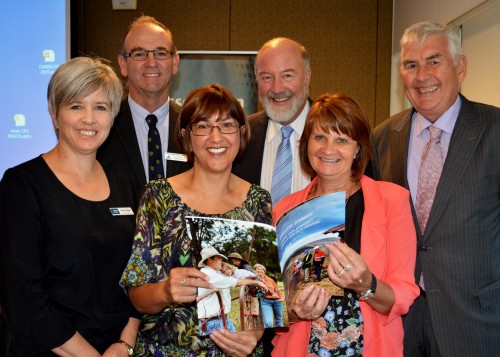The Association of Mining Related Councils (AMRC) has continued its pre-election appeal to the NSW Government for an in-depth mining impact analysis. Association Chair and Warrumbungle Shire Mayor Peter Shinton said that it is time that Minister for Resources and Energy, the Hon. Anthony Roberts got genuinely resourced with grassroots mining impacts knowledge and stopped being reactionary with mining related policies.

Blayney Shire Council General Manager Rebecca Ryan and Mayor Scott Ferguson, Western Research Institute CEO Danielle Ranshaw with her Cadia mine impacts report in hand, Association of Mining Related Councils Chair Cr. Peter Shinton, Cabonne Shire Councillor Sharon Wilcox and CEO of the Association Don Tydd.
“We have seen the benefits of a holistic inquiry into infrastructure and social impacts mining has on a community through a study undertaken by the Western Research Institute for Newcrest Mining Limited, Cadia Valley Operations. This comprehensive study looked at both mining impacts and the implications for the regional city of Orange and other nearby centres, if the Cadia gold mine was to shut down. Just as councils deserve a better return from the mining royalties the State Government extracts from their areas, they should also have all the information possible to best manage mining impacts, including the massive adjustments that come with a mine closure,” Cr. Shinton said.
“Any council would benefit from this level of awareness, particularly when negotiating Voluntary Planning Agreements (VPA’s). We need the NSW Government to lay the foundations for local studies, with a comprehensive inquiry.”
“Mining communities need to keep monitoring their health, strengths, weaknesses and changes that occur in the community and its economy, as the result of mining. This can be done with a large study like what was done for Cadia but there can also be advantages from regular monitoring on a smaller scale, following solid foundation analysis. Ongoing engagement with the local business community, service providers, people involved in the housing sector can also be important in both gauging and informing about mining impacts. This regular monitoring and community liaison can help local councils and mining operations to be aware of mining impacts and ensure the best possible means of addressing them are in place,” said Western Research Institute CEO Danielle Ranshaw.
In a presentation to the Association of Mining Related Councils, Ms Ranshaw outlined what the report “Economic, social & community impacts of Cadia Valley operations” entailed, together with the outcomes and conclusions from it. The in-depth study saw the mining operation identify needs and voluntarily make additional investments into the local community.” A mining company can only benefit from comprehensive awareness and community engagement. Just like governments, if mine operators understand their impacts they can tailor or implement strategies to ensure the community thrives whilst the mine is there and post-mining.”
Cr Shinton said that the Cadia study at Orange set an excellent benchmark and applauded the mining operation for commissioning it. “The benefits of this kind of study are clear. We cannot expect such an initiative to be undertaken by all mine operators across NSW and councils do not have the resources – the State Government does and it is time we saw long, as well as short-term mining policy underpinned by real consultation, investigation and analysis.”
Download Media Release – NSW Mining affected councils continue Government inquiry call (pdf)

You must be logged in to post a comment.